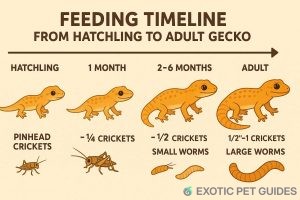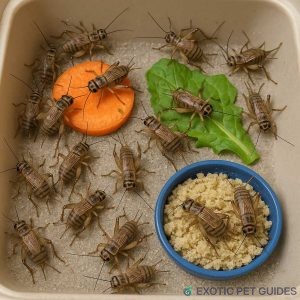🦎 Introduction
Feeding your leopard gecko isn’t just about what you feed—it’s about when and how often. A proper schedule ensures your gecko gets the nutrients it needs at every life stage, from baby to adult.
In this guide, you’ll get a complete feeding chart by age, know what insects to offer, how much to feed, and when to switch up routines.

🐣 Feeding Chart by Age
| Age Group | Feeding Frequency | Number of Insects per Meal | Notes |
|---|---|---|---|
| 0–3 months | Daily | 5–7 small insects | Prioritize small crickets, BSFL |
| 3–6 months | Daily | 6–8 medium insects | Add variety (dubia, silks) |
| 6–12 months | Every other day | 6–8 medium/large insects | Start tapering to adult diet |
| 12+ months | 2–3x per week | 6–10 large insects | Adults eat less often |
📝 Note: Always adjust based on appetite, weight, and activity level.

🦗 What to Feed
✅ Safe & nutritious feeder insects:
- Crickets
- Dubia roaches
- Black soldier fly larvae (high calcium)
- Mealworms (moderation)
- Silkworms (hydration)
❌ Avoid:
- Wild-caught bugs
- Fireflies (toxic)
- Large hornworms (for small geckos)
🧂 Supplements & Gut-Loading
🟢 Calcium with D3:
- 2x/week for geckos without UVB
- 1x/week with UVB lighting
🟡 Multivitamin Powder:
- 1x/week
🌿 Gut-Loading Feeders:
24 hours before feeding, gut-load with:
- Carrots
- Leafy greens
- Commercial gut-load formulas

💧 Hydration Tips
- Leopard geckos don’t usually drink while you watch
- Always provide a shallow clean water dish
- Add hornworms or silkworms for extra hydration
- Mist enclosure lightly if needed (not daily)
⚖️ How to Monitor If You’re Feeding Enough
🔍 Check these signs weekly:
✅ Healthy signs:
- Consistent appetite
- Full tail (fat storage)
- Alertness and activity
❌ Warning signs:
- Refusal to eat multiple times
- Tail becoming thin
- Weight loss

🐾 Conclusion
Leopard geckos are low-maintenance eaters, but they still need the right food at the right time. Follow an age-appropriate feeding schedule, use high-quality insects, and track your gecko’s health to raise a happy, thriving pet.